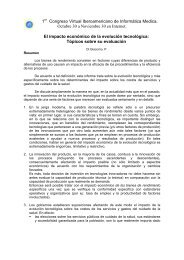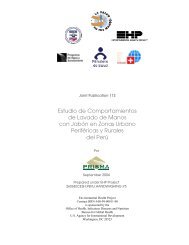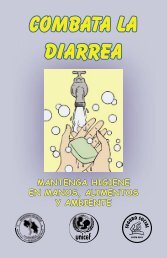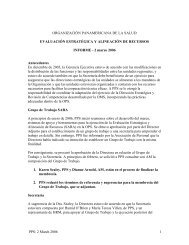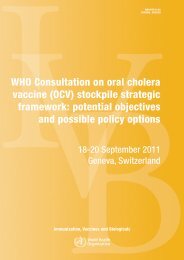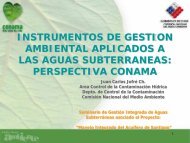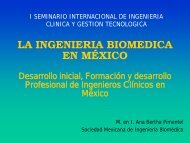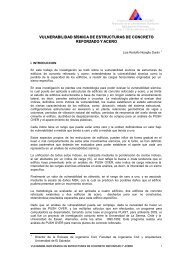a database of the National Library of M
a database of the National Library of M
a database of the National Library of M
You also want an ePaper? Increase the reach of your titles
YUMPU automatically turns print PDFs into web optimized ePapers that Google loves.
workers to <strong>the</strong> vinyl chloride monomer (VCM) for different periods <strong>of</strong> timewould cause DNA damage, using <strong>the</strong> single-cell gel electrophoresis (SCGE)technique. Levels <strong>of</strong> DNA damage was assessed by both extent <strong>of</strong> DNAmigration & numbers <strong>of</strong> DNA damaged spots in <strong>the</strong> peripheral bloodlymphocytes from 32 plastics workers with different periods <strong>of</strong> exposure toVCM; <strong>the</strong>y were evaluated by comparison with a group <strong>of</strong> non-exposedindividuals. It was found that plastics workers who were exposed to VCMfor different periods <strong>of</strong> time showed significantly increased levels <strong>of</strong> DNAdamage compared with <strong>the</strong> non-exposed subjects. There was a significantcorrelation between <strong>the</strong> severity <strong>of</strong> DNA damage & duration <strong>of</strong> exposure.However, no significant correlation was found between <strong>the</strong> age <strong>of</strong> allsubjects & DNA damage. Concns <strong>of</strong> VCM in <strong>the</strong> air inside <strong>the</strong> factorywere found to be significantly higher than values in non-exposed areas,despite being lower than <strong>the</strong> threshold limit value (TLV). Our resultsencourage <strong>the</strong> application <strong>of</strong> SCGE as a sensitive, simple, fast &useful technique in <strong>the</strong> regular health screening <strong>of</strong> workers occupationallyexposed to VCM (even at concns below <strong>the</strong> TLV) to assess <strong>the</strong> possibility <strong>of</strong>any DNA damage. [Awara WM et al; Toxicology 128 (1): 9-16 (1998)]**PEERREVIEWED**N-acetyl-S-(2-hydroxyethyl)-L-cysteine (2-hydroxyethyl mercapturic acid,HEMA) is a urinary metabolite <strong>of</strong> several hazardous chemicals, includingvinyl chloride (VC), ethylene oxide (EO), & ethylene dibromide (EDB).Information about <strong>the</strong> levels <strong>of</strong> HEMA in <strong>the</strong> general population is usefulfor assessing human exposures to HEMA parent cmpds, including VC, EO,& EDB. To establish reference range concns for HEMA, we analyzed urinesamples from 412 adult participants in <strong>the</strong> Third <strong>National</strong> Health &Nutrition Examination Survey (NHANES II) by using isotope-dilutionhigh-performance liquid chromatography-tandem mass spectrometry(HPLC-MS/MS). HEMA was detected in 71% <strong>of</strong> <strong>the</strong> samples examined.Creatinine-corrected concns ranged from < 0.68 ug/g creatinine to 58.7microg/g creatinine; <strong>the</strong> 95th percentile concn was 11.2 ug/g creatinine;& <strong>the</strong> geometric mean & median creatinine-corrected concns wereboth 1.6 ug/g creatinine. We observed a statistically significantdifference (P=0.0001) in <strong>the</strong> creatinine-corrected geometric mean concnvalues <strong>of</strong> HEMA between smokers (2.8 ug/g creatinine) & nonsmokers (1.1ug/g creatinine). The high levels <strong>of</strong> HEMA seen among smokers likelyoriginated from HEMA-producing chemicals known to be present in tobaccosmoke. [Calafat AM et al; J Expo Anal Environ Epidemiol 9 (4): 336-342(1999)]**PEER REVIEWED**/The authors/ investigated whe<strong>the</strong>r exposure to ethylene dichloride (EDC)& vinyl chloride monomer (VCM) resulted in increased risk <strong>of</strong> liverdamage. Epidemiological information, including occupational, medical,smoking, & drinking history, was obtained by interview from 251 maleworkers. Serum alanine aminotransferase (ALT), aspartate aminotransferase(AST), & gamma-glutamyltransferase (GGT) were used as indicators <strong>of</strong>liver damage. Exposure to moderate or low levels <strong>of</strong> ECD & VCM resultedin a higher risk <strong>of</strong> developing abnormal ALT levels than did exposure tolower levels <strong>of</strong> <strong>the</strong> chemicals. Results were similar for AST. GGT was notassociated with EDC or VCM exposure. Combined exposure to EDC & VCMshowed a dose-response relationship in association with abnormal ALTlevels. ... Relatively low concns <strong>of</strong> VCM & EDC cause liver damage.[Cheng TJ et al; J Occup Environ Med 41 (12): 1128-1133 (1999)]**PEERREVIEWED**OBJECTIVES: To determine if <strong>the</strong>re is an increased risk <strong>of</strong> admission to



